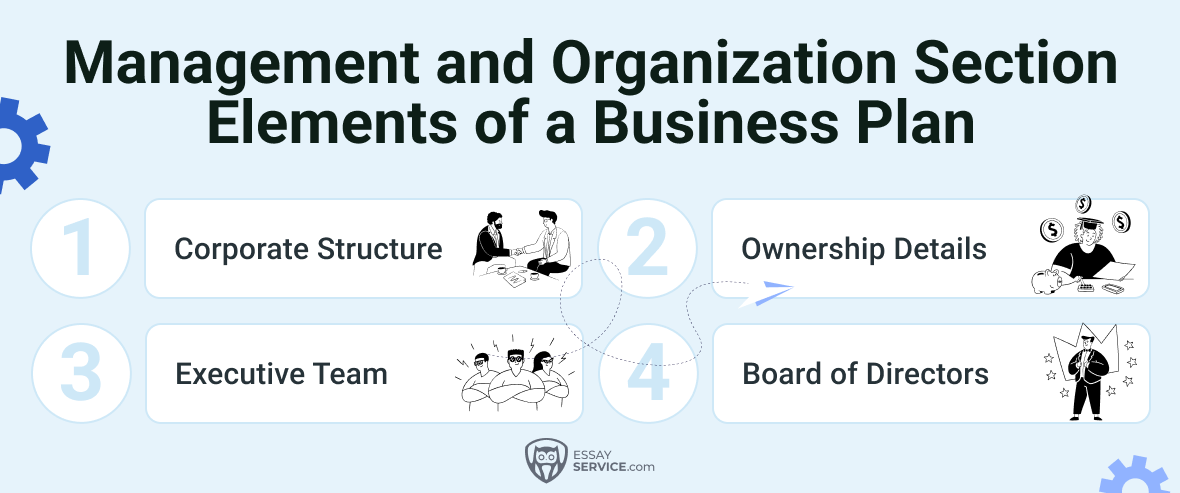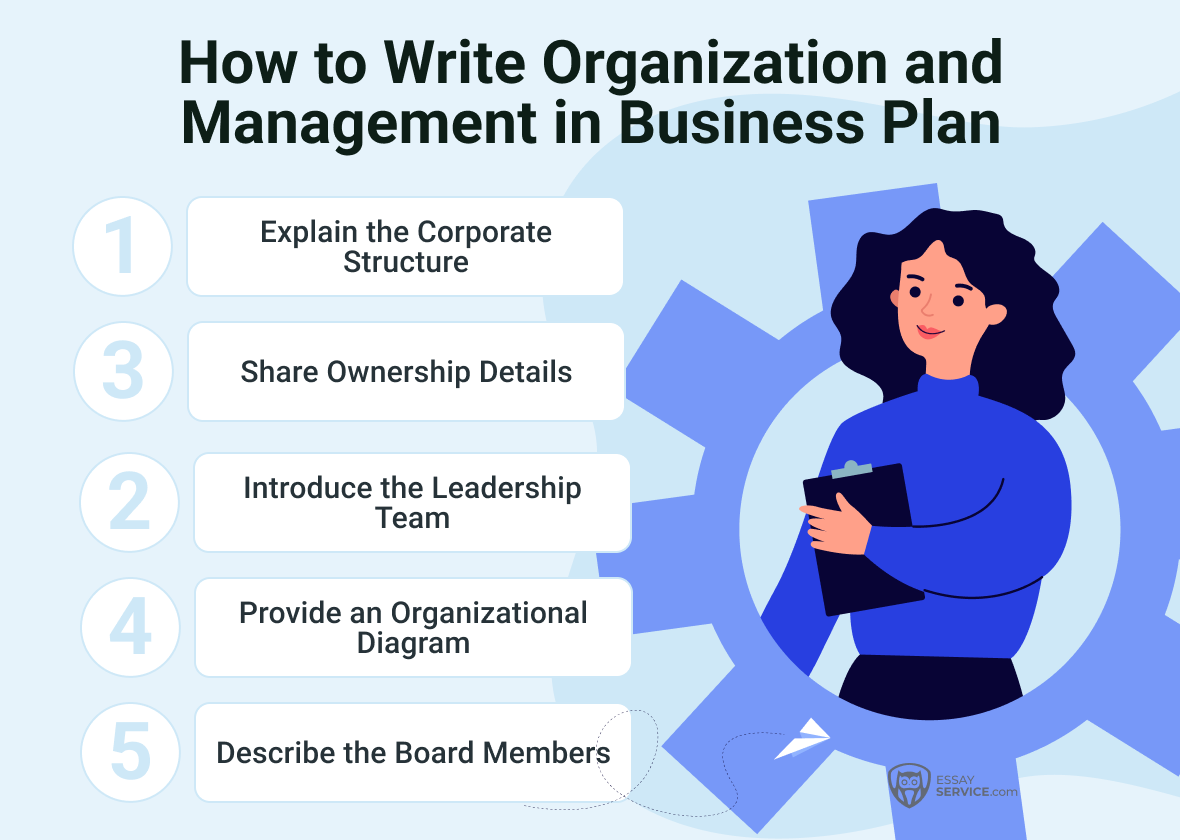Have you ever wondered who's behind the scenes driving a company's success? The Organization and Management section of a business plan does just that—it introduces you to the key players responsible for the day-to-day operations. Why is this crucial? Because understanding the team's structure, the management hierarchy, and the strategic advisory plans can make or break an investor's decision.
This section offers vital insights into whether your staff possesses the necessary experience, skills, and pedigree to achieve the ambitious goals outlined in the rest of your business plan. Are your leaders capable of navigating challenges and seizing opportunities? This is where you prove it, providing the critical information stakeholders need to trust in your company's potential.
Many might underestimate this section, thinking it's less significant than financial forecasts or market analysis. But let's be clear: your people are your business. If your team is highly competent and accomplished, it reflects directly on the potential success of your business. This crucial point is emphasized in our guide on what is business management, so be sure to give it a read.
Meanwhile, let's go deeper into the management and organization description in business plan and find out how to write one effectively below.
What is Organization and Management Business Plan?
The management and organization section of a business plan is designed to provide a detailed look at your company's structure and the team behind it. Positioned typically after the executive summary, though sometimes following the market analysis section, this part of your plan is essential for showcasing the internal framework and leadership of your business. This section is usually divided into two key parts.
The first part covers the overall organization of your company. Here, you should:
- Present an overview of your business structure.
- Explain your legal setup (LLC, nonprofit, partnership, etc.).
- Even if you're a sole proprietor or running a home business, including company registration details adds valuable context.
The second part focuses on your management team. This is your opportunity to:
- Introduce readers to the key individuals who lead your company.
- Highlight their qualifications, experience, and achievements.
- Demonstrate their capability to drive the business toward its goals.
- Showcase the strength and expertise of your team, instilling confidence in potential investors and stakeholders and reinforcing the credibility and potential success of your business.
Purpose of the Management and Organization Business Plan
The Organization and Management in business plan serves multiple critical purposes, providing a clear picture of the company's internal framework and leadership capabilities. Here are key points:
- Clearly defines the company's structure and hierarchy.
- Outlines roles and responsibilities of different departments and team members.
- Provides detailed profiles of the leadership team, highlighting their qualifications and experience.
- Demonstrates the company's capability to achieve its objectives under competent management.
- Lists ownership details, showing the distribution of shares and control.
- Includes information about the board of directors, showcasing governance and strategic oversight.
- Demonstrates that the company has a well-organized structure to implement its business strategies.
- Shows preparedness for growth and scalability with a strong organizational foundation.
Struggling to Articulate Your Management Strategy in Your Business Plan?
Don’t let a mediocre section hold back a stellar plan! From leadership structures to management philosophies, we’ve got you covered.
Main Elements of the Management and Organization Section of Business Plan
As we already discussed, the business plan organization and management section provides a comprehensive overview of the company's internal framework and leadership. This section is crucial for demonstrating to investors, partners, and stakeholders that the business is well-organized and has a capable team to execute its strategies. Below, we discuss the main elements that should be included in this section.

Corporate Structure
The company structure in business plan outlines the overall framework of the company, detailing how different departments and teams are organized and how they interact with each other. This part of the business plan should include an organizational chart that visually represents the hierarchy and reporting relationships within the company. A clear corporate structure ensures that every team member understands their role and responsibilities, which is essential for efficient operation and effective communication.
Ownership Details
Providing ownership details is essential for transparency and helps potential investors understand who holds the controlling interest in the company. This section should list the principal owners or shareholders and their respective stakes in the business. Additionally, it should include any pertinent information about the ownership structure, such as the distribution of shares and voting rights. Clarity in ownership details can build trust and credibility with investors and other stakeholders.
Executive Team
The management team in business plan should introduce the key leaders of the company, highlighting their qualifications, experience, and specific roles. Each team member's bio should demonstrate their capability and track record in managing and growing businesses. This section is crucial for convincing investors that the company has a competent and experienced leadership team that can navigate challenges and drive the business toward its goals.
Board of Directors
Including information about the board of directors is important for demonstrating the company's governance framework. This section should list the board members, along with their professional backgrounds and the expertise they bring to the company. The board of directors plays a critical role in providing strategic guidance and oversight, and having a strong, well-qualified board can significantly enhance the company's credibility and appeal to investors.

How to Write Organization and Management in Business Plan?
Explain the Corporate Structure
Begin by explaining the corporate structure of your company. This involves:
- Detailing how the organization is set up, including the various departments and teams, and how they interact.
- Describing the hierarchy within the company, specifying the chain of command and the flow of communication.
- Clarifying the roles and responsibilities of different departments and how they contribute to the overall objectives of the business.
A well-defined corporate structure ensures that each part of the organization functions efficiently and that there is clear accountability.
Share Ownership Details
Next, share the company's ownership details. This step involves listing the major shareholders or owners and their respective stakes in the business. Include any relevant information, such as:
- Names of owners
- Percentage ownership
- Involvement level with the company
- Forms of ownership (e.g., common stock, preferred stock, general partner, limited partner)
- Outstanding equity equivalents (e.g., options, warrants, convertible debt)
- Common stock (e.g., authorized or issued)
Providing this information transparently helps build trust with potential investors and stakeholders, as they can see who holds the control and how ownership is structured.
Introduce the Leadership Team
Introducing the leadership team is a critical part of this section. Provide detailed profiles of the key executives, highlighting their professional backgrounds, expertise, and roles within the company. This helps to demonstrate that the company is led by a competent and experienced team capable of guiding it towards success. So, make sure to provide resumes that include this information:
- Name
- Position description and primary duties
- Primary responsibilities and authority
- Education
- Unique experience and skills
- Prior employment
- Special skills
- Track record
- Industry recognition
- Community involvement
- Years with the company
- Compensation basis and levels
Provide an Organizational Diagram
Including a diagram in your section on management for business plan is essential for visually representing the corporate structure. This diagram should clearly illustrate the hierarchy within the company, showing the different departments and their leaders, as well as the reporting relationships among staff. An effective organizational chart can help readers quickly understand how the company is organized and the lines of communication. Ensure the diagram is easy to read and accurately reflects the current structure of the company.
Describe the Board Members
Finally, describe the board members, if applicable. This section should list the members of the board of directors and provide detailed bios for each, such as:
- Names
- Board positions
- Level of involvement with the company
- Background information
- Past and prospective contributions to the company's achievements

Also, make sure to highlight their professional backgrounds, areas of expertise, and the value they bring to the company. Discuss any relevant experience they have in the industry and their roles in providing strategic guidance and oversight. Having a strong board of directors can greatly enhance the company's credibility and reassure investors of the soundness of its governance.
Is Your Business Plan Lacking That Winning Strategy?
With our professional touch, your plan will stand out for its strategic brilliance and organizational clarity.
Organization and Management Business Plan Example
Now that we've wrapped our heads around the theory and the guide, let's dive into a practical example for more clarity and understanding of the concept:
Executive Summary: TechStar Solutions is a cutting-edge tech startup aimed at revolutionizing the way businesses manage their data and streamline operations. Our innovative software platform offers advanced data analytics and automation tools, empowering companies to make smarter decisions and optimize efficiency. With a seasoned team of industry experts leading the charge, TechStar Solutions is poised to disrupt the market and drive significant growth in the coming years.
Organization Overview: TechStar Solutions operates as a limited liability company (LLC), headquartered in Silicon Valley. Our organizational structure consists of three main departments: Product Development, Sales & Marketing, and Operations. Each department is led by experienced professionals dedicated to driving excellence and innovation in their respective domains.
Ownership Details:
- Founders: John Smith (60% ownership) and Emily Johnson (40% ownership)
- Both founders are actively involved in the day-to-day operations of the company and bring extensive experience in software development and business management.
- Ownership is divided based on initial investment and ongoing contributions to the company's growth.
- TechStar Solutions operates under a common stock ownership structure, with authorized shares allocated to the founders.
Management Team:
John Smith (CEO & Co-founder):
- Oversees overall company strategy and vision.
- Holds a Master's degree in Computer Science and has over 10 years of experience in software development.
- Previously worked at leading tech firms, including Google and Facebook.
Emily Johnson (COO & Co-founder):
- Manages daily operations and ensures operational efficiency.
- Holds an MBA with a focus on Operations Management and has a proven track record of scaling startups.
- Formerly held leadership roles at several successful tech startups.
Michael Williams (CTO):
- Leads the Product Development team and drives technology innovation.
- Holds a Ph.D. in Computer Engineering and has extensive experience in software architecture and development.
- Previously worked at Fortune 500 companies, specializing in cloud computing and artificial intelligence.
Board of Directors:
- John Smith (Chairman)
- Emily Johnson (Board Member)
- Michael Williams (Board Member)
- Sarah Lee (Independent Director)
- David Chen (Independent Director)
- The board provides strategic guidance and oversight, ensuring alignment with company goals and objectives.
- Independent directors bring diverse expertise in finance, marketing, and corporate governance, enhancing the board's effectiveness.
Conclusion: With a solid organizational structure and a highly skilled management team at the helm, TechStar Solutions is well-positioned to disrupt the tech industry and achieve significant growth. Our commitment to innovation, coupled with strong leadership and strategic governance, will drive success and deliver value to our customers and stakeholders.
FAQs
Why Is Organization and Management Business Plan Important?
An Organization and Management section is crucial in a business plan because it outlines the company's organizational structure and details the management team, which demonstrates to investors and stakeholders that the business has a solid foundation and capable leadership. This section provides clarity on roles, responsibilities, and the hierarchy within the company, helping to establish trust and confidence in the business's ability to execute its strategies and achieve its goals.
What Is Needed to Create a Business Plan Organization and Management?
To create an effective Organization and Management section in a business plan, you need to gather detailed information about the company's organizational structure, including charts that outline the hierarchy and reporting relationships. You also need comprehensive profiles of the management team and key staff members, highlighting their qualifications, experience, and roles within the company. Additionally, include information about the board of directors or advisors, if applicable, and their contributions to the business.
What to Write for Organization and Management in Business Plan?
In the Organization and Management section of a business plan, you should describe the company's organizational structure and provide an organizational chart that illustrates the hierarchy and reporting relationships. Include detailed biographies of the management team, highlighting their professional backgrounds, expertise, and roles within the company. If applicable, provide information about the board of directors or advisory board, emphasizing their qualifications and how they contribute to the company's strategic direction and success.
Summing Up
As you polish your business plan, reflect on what we've learned. Remember to infuse it with the vibrancy of your team's story. Share the triumphs, the challenges, and the unwavering determination that propels you toward success. Because ultimately, it's the human element that sets your business apart.
It's the dedication of your team, the depth of their expertise, and the unwavering commitment to your vision that fuels the engine of success. So, as you finalize your organization and management business plan, celebrate the human stories behind the strategies.
- Business Plan - management and organization. (n.d.). The Business Professor, LLC. https://thebusinessprofessor.com/en_US/business-management-amp-operations-strategy-entrepreneurship-amp-innovation/business-plan-management-and-organization
New posts to your inbox!
Your submission has been received!



